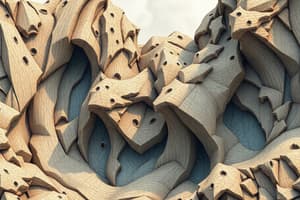Podcast
Questions and Answers
What type of fold has an essentially vertical axial plane, with limbs of equal length dipping equally in opposite directions?
What type of fold has an essentially vertical axial plane, with limbs of equal length dipping equally in opposite directions?
Symmetrical fold
What is the term for folds with unequal limbs that dip unequally on either side of the hinge line?
What is the term for folds with unequal limbs that dip unequally on either side of the hinge line?
Asymmetrical fold
What type of fold has an axial plane that is inclined, with both limbs dipping essentially in the same direction?
What type of fold has an axial plane that is inclined, with both limbs dipping essentially in the same direction?
Overturned fold
What is the term for a group of folds where all axial planes are parallel, resulting in equal dipping of component limbs?
What is the term for a group of folds where all axial planes are parallel, resulting in equal dipping of component limbs?
What type of fold has an axial plane that acquires an almost horizontal attitude?
What type of fold has an axial plane that acquires an almost horizontal attitude?
What is the term for a pair of folds with mutually inclined axial planes?
What is the term for a pair of folds with mutually inclined axial planes?
What type of fold has an exceptionally flattened top and steeply inclined limbs?
What type of fold has an exceptionally flattened top and steeply inclined limbs?
What is the term for a fold that results from slight compression, without appreciable variation in rock thickness?
What is the term for a fold that results from slight compression, without appreciable variation in rock thickness?
What type of fold results from severe compression, involving plastic movement of rock masses and resulting in thinner limbs and thicker crests?
What type of fold results from severe compression, involving plastic movement of rock masses and resulting in thinner limbs and thicker crests?
What is the term for folds in which the degree of folding remains similar for indefinite depths?
What is the term for folds in which the degree of folding remains similar for indefinite depths?
Flashcards are hidden until you start studying
Study Notes
Types of Folds
- Supratenuous folds: show differences in thickness at the crestal and trough regions, not induced by folding process, but by erosional and depositional processes.
Classification of Folds
Based on Relative Curvature
- Class 1 folds: outer arc curvature less than inner arc curvature
- Class 2 folds: equal curvature of inner and outer arcs
- Class 3 folds: outer arc curvature greater than inner arc curvature
Based on Plunge
- Plunging fold: fold axis not horizontal
- Non-plunging fold: fold axis horizontal
Based on Profile of Fold Surface
- Chevron folds: well-defined, sharp hinge points and straight planar limbs
- Conjugate folds: composite folds with 2 hinges, 3 planar limbs, and a flattened central limb
- Cylindrical folds: resemble sections of pipes with well-defined axes repeated parallel to each other
Based on Mode of Occurrence
- Anticlinorium: large-sized folds, often several hundred kilometers in length and width, with an up-arched folding trend
- Synclinorium: reverse of anticlinorium, with a down-arched folding trend
- Domes and basins: centrally uplifted or down-arched strata, with folding occurring
Parts of a Fold
- Limbs: sides of a fold
- Hinges: maximum curvature point of a fold, where one limb ends and another limb starts
- Axial surface: surface obtained by tracing the hinge line throughout the depth of the folded sequence
- Axial plane: imaginary plane containing all the hinges of a fold
- Axis of fold: line drawn parallel to the hinge line of a fold or the line representing the intersection of the axial plane with any bed of the fold
- Plunge of a fold: angle of inclination of the fold axis with the horizontal as measured in a vertical plane
- Crest and trough: lines running through the highest and lowest points in an up-arched and down-arched fold, respectively
Classification of Folds
- Anticlines: up-arched folds, with geologically older rocks in the interior, and the youngest at the outermost flank
- Synclines: down-arched folds, with geologically younger rocks in the core, and the oldest at the outer flanks
Based on Position of Axial Plane
- Symmetrical folds: limbs are equal in length, dip equally in opposite directions, and the axial plane is vertical
- Asymmetrical folds: limbs are unequal in length, dip unequally on either side from the hinge line
- Overturned folds: limbs dip essentially in the same direction, with inclined axial planes
- Isoclinal folds: all axial planes are parallel, with limbs dipping at equal amounts
- Recumbent folds: axial planes acquire almost horizontal attitude
- Conjugate folds: pair of folds with mutually inclined axial planes
- Box fold: exceptionally flattened top and steeply inclined limbs
Based on Degree of Compression
- Open fold: layers of rocks compressed only slightly, with no appreciable variation in thickness
- Closed fold: layers of rocks compressed severely, with plastic movement of rock masses resulting in thinner limbs and thicker crests or troughs
Based on Behaviour with Depth
- Concentric folds: thickness of involved layers remains uniform and constant even after folding
- Similar folds: degree of folding is similar for indefinite depths
Studying That Suits You
Use AI to generate personalized quizzes and flashcards to suit your learning preferences.



